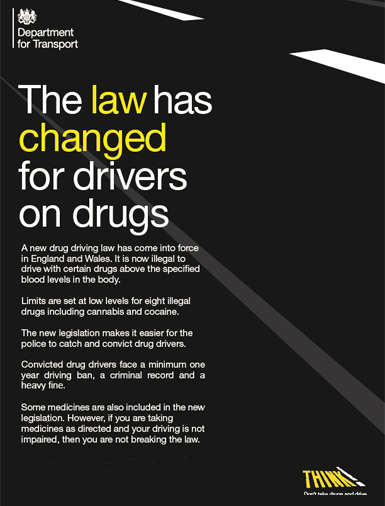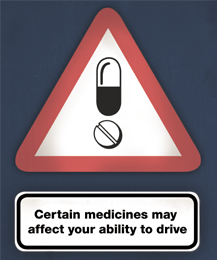A special report by Dave Joyce, CWU’s National Health, Safety & Environment Officer:
 Stricter new Laws aimed at stopping people driving while on drugs have come into force in England and Wales. The drug driving law came into effect on 2nd March 2015 in England and Wales changed to make it easier for the police to catch and convict drug drivers. It is also due to be enforced in Scotland once approved by the Scottish Parliament and the introduction of a similar offence is under consideration in Northern Ireland.
Stricter new Laws aimed at stopping people driving while on drugs have come into force in England and Wales. The drug driving law came into effect on 2nd March 2015 in England and Wales changed to make it easier for the police to catch and convict drug drivers. It is also due to be enforced in Scotland once approved by the Scottish Parliament and the introduction of a similar offence is under consideration in Northern Ireland.
This new offence will be section 5A of the Road Traffic Act 1988, which is inserted by section 56(1) of the Crime and Courts Act 2013. It will work very much in the same way as the current drink drive offences (section 5 of the Road Traffic Act 1988) and carry similar penalties.
Police are now be able to use new portable drug testing equipment, known as "drugalyser" devices at the roadside to screen for drugs such as Cannabis and Cocaine at the roadside. Officers will also be able to test for these and other drugs including Ecstasy, LSD, Ketamine and Heroin. Police also have the power to enforce further tests at a police station, even if a driver passes the roadside check. It is expected that more advanced Testers will be developed in the future. Previously officers had to arrest suspects and take them to a police station to undergo time-consuming blood tests conducted under medical supervision.
If drugs are detected in a driver's system at the roadside using a drug screening device or they are deemed impaired by drugs, they’ll be arrested and taken to a police station for blood or urine tests. If the tests show the person has taken illegal drugs or shows a specified drug above the specified blood limits the individual can be charged with drug driving.
The new regulations set low levels for the eight illegal drugs, with higher levels set for eight prescription drugs, including morphine and methadone. Drivers face prosecution if they exceed limits set for the presence of the eight illegal drugs and eight prescription drugs. It is now an offence to drive with these drugs above a specified level in the blood - just as it is with drink driving. Sixteen legal and illegal drugs are covered by the law, including cannabis, cocaine, ecstasy and ketamine. The limits for all illegal drugs are extremely low – taking even a very small amount of an illegal drug could put a driver over the limit.
Those using prescription drugs within recommended amounts will not be penalised. The situation for people who use prescription drugs has not changed, but the onus is on the individual to assure themselves that their driving ability is not impaired. It has been recommended that drivers who take prescription drugs should carry proof so they can produce it at the roadside if needed after being stopped by the Police and tested.
 As Royal Mail and BT operate two of the largest fleets in the UK and Europe and as such a large number of CWU members drive as part or all of their job, this is an important matter as it affects both illegal and prescription drugs with the new regulations setting levels for 8 illegal and 8 legal prescription drugs.
As Royal Mail and BT operate two of the largest fleets in the UK and Europe and as such a large number of CWU members drive as part or all of their job, this is an important matter as it affects both illegal and prescription drugs with the new regulations setting levels for 8 illegal and 8 legal prescription drugs.
The importance here is raising awareness of those drivers who take prescription medications, regarding staying within the recommended amounts and taking medicine as directed, and not being impaired, in order to avoid breaking the law and being penalised. It may help for those on medication to possibly carry proof so they can produce it at the roadside, following a Police stop and Roadside Testing, if necessary, to avoid legal complications.
Road Safety Campaigners such as Roadpeace, Brake, RoSPA and others have welcomed the new rules which these organisations, the Government and the Police say will save lives.
The CWU would certainly support any new rules and tools to improve driver and road safety as well as holding those to account who would break the law and put other innocent road users, drivers and pedestrians at risk.
Some motoring lawyers have expressed concerns regarding the impact on prescription drug users, particularly those prescribed powerful anxiety or pain relief drugs and therefore awareness of the rules and caution is the message we wish to convey to members in this category.
However the Road Safety Minister has stated that prescribed doses of legal drugs given to patients by Hospitals and GPs do not exceed the limits for legal drugs, so most patients should still be safe to drive so long as they stay within the prescribed limits. The Minister said that If a driver is taking his/her medicine as directed and their driving is not impaired, then they are not breaking the law and there is no need to worry as they will not be unfairly penalised.
Some prescription or over-the-counter medicines can also impair the ability to drive but advice is normally given at the time they are prescribed. If you’re taking medicines, talk to your doctor, pharmacist or healthcare professional before driving. Basically, there is no need to stop taking medication or to give up driving so long as:
- you do not drive when you believe you might be unfit or impaired, and
- you stay within any driving restrictions given by the prescriber/supplier of the drug and in the information leaflet with the medication/drug
Those who are unsure or concerned about how medicine drugs might affect their driving should seek the advice of their GP, Pharmacist or healthcare professional before driving. They will be happy to assist and give advice needed to stay safe and legal.
The new rules run alongside the existing law, under which it is an offence to drive when impaired by any drug. The existing penalties mean drug drivers already face a fine up to £5,000, up to six months in prison and a minimum one-year driving ban.
The new rules are expected to work as a much stronger deterrent and make prosecutions much easier under the 'zero-tolerance' approach.
The following prescription and illicit drugs will be included in this new law.
The limits are also included and effectively relate to a zero-tolerance policy for illicit substances.
|
Generally prescription drugs |
Illicit drugs |
clonazepam, 50 µg/L
diazepam, 550 µg/L
flunitrazepam, 300 µg/L
lorazepam, 100 µg/L
methadone, 500 µg/L
morphine, 80 µg/L
oxazepam, 300 µg/L
temazepam, 1000 µg/L |
benzoylecgonine, 50 µg/L
cocaine, 10 µg/L
delta–9–tetrahydrocannabinol (cannabis and cannabinol), 2 µg/L
ketamine, 20 µg/L
lysergic acid diethylamide (LSD), 1 µg/L
methylamphetamine (Crystal Meth or Ice), 10 µg/L
methylenedioxymethaphetamine (MDMA – ecstasy), 10 µg/L
6-monoacetylmorphine (6-MAM – heroin and diamorphine), 5 µg/L |
The Prescription drugs covered by the new law
- Clonazepam is prescribed to treat seizures or panic disorders
- Diazepam is used for anxiety disorders, alcohol withdrawal symptoms or muscle spasms
- Flunitrazepam (also known as Rohypnol) is a sedative originally used in hospitals for deep sedation in the 1970s
- Lorazepam is used to treat convulsions or seizures caused by epilepsy
- Oxazepam is used to relieve anxiety, including anxiety caused by alcohol withdrawal
- Temazepam affects chemicals in the brain that may become unbalanced and cause insomnia problems
- Methadone is used in the treatment of heroin addiction and for pain relief
- Morphine or opiates treat moderate to severe pain
The Consequences
The penalties for drug driving are the same as for drink driving. If you are convicted you will receive:
- A minimum 12-month driving ban
- A criminal record
- A fine of up to £5000 or up to 6 months in prison or both
The consequences of a drug drive conviction are far reaching and can include:
- Job loss
- Loss of independence
- The shame of having a criminal record
- Increase in car insurance costs
- Trouble getting in to countries like the USA
Over 900 UK drivers fail drugalyser test in two months
 Figures collected from county police forces in the UK show that 902 motorists failed drugalyser tests in the first two months of the new Law being introduced. The statistics cover the period from 2 March to 11 May 2015 and all those who failed were then arrested on suspicion of driving under the influence of drugs.
Figures collected from county police forces in the UK show that 902 motorists failed drugalyser tests in the first two months of the new Law being introduced. The statistics cover the period from 2 March to 11 May 2015 and all those who failed were then arrested on suspicion of driving under the influence of drugs.
The Institute of Advanced Motorists requested the figures from the government under Freedom of Information laws. The figures show that London’s Metropolitan Police Force arrested the biggest proportion of suspected drug-drivers with a tally of 214.
Northumbria came second with 97 and was followed by Cheshire with 70. Sussex notched up fourth with 58 arrests. The figures indicated that officers in Gwent, Warwickshire and Leicestershire had not arrested anybody on suspicion of drug-driving up to 11 May. The figures are not a truly accurate representation of how the new law is working as six of the police forces in England and Wales did not supply any data for the report.
We hope that the law will help the government stamp out the problem posed by people driving when they were not fit to. People who drive while under the influence of drugs are a danger to other road users as well as to themselves.
This report was first issued to all CWU branches in LTB482/15 and included the following attachments:
- Drug Drive Limits 2015 - DDE Guide
- Drug Drive Law Change DOT Poster
- Drug Drive Legal Drugs Poster
- Drug Driving - Effects of Drugs on Drivers
- Drug Driving Rules DOT Leaflet
- Drug Driving (Specified Limits) (England & Wales) Regulations 2014
- Drugalyser - Drager 5000
- Drugalyser - Securitec DrugWipe
- Drugalyser - Cozart Rapidscan
You can download the full LTB here
Source: CWU


 Stricter new Laws aimed at stopping people driving while on drugs have come into force in England and Wales. The drug driving law came into effect on 2nd March 2015 in England and Wales changed to make it easier for the police to catch and convict drug drivers. It is also due to be enforced in Scotland once approved by the Scottish Parliament and the introduction of a similar offence is under consideration in Northern Ireland.
Stricter new Laws aimed at stopping people driving while on drugs have come into force in England and Wales. The drug driving law came into effect on 2nd March 2015 in England and Wales changed to make it easier for the police to catch and convict drug drivers. It is also due to be enforced in Scotland once approved by the Scottish Parliament and the introduction of a similar offence is under consideration in Northern Ireland. As Royal Mail and BT operate two of the largest fleets in the UK and Europe and as such a large number of CWU members drive as part or all of their job, this is an important matter as it affects both illegal and prescription drugs with the new regulations setting levels for 8 illegal and 8 legal prescription drugs.
As Royal Mail and BT operate two of the largest fleets in the UK and Europe and as such a large number of CWU members drive as part or all of their job, this is an important matter as it affects both illegal and prescription drugs with the new regulations setting levels for 8 illegal and 8 legal prescription drugs.  Figures collected from county police forces in the UK show that 902 motorists failed drugalyser tests in the first two months of the new Law being introduced. The statistics cover the period from 2 March to 11 May 2015 and all those who failed were then arrested on suspicion of driving under the influence of drugs.
Figures collected from county police forces in the UK show that 902 motorists failed drugalyser tests in the first two months of the new Law being introduced. The statistics cover the period from 2 March to 11 May 2015 and all those who failed were then arrested on suspicion of driving under the influence of drugs.